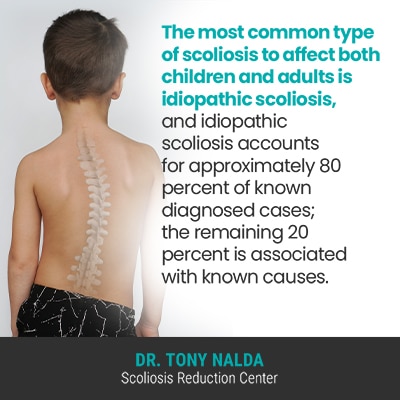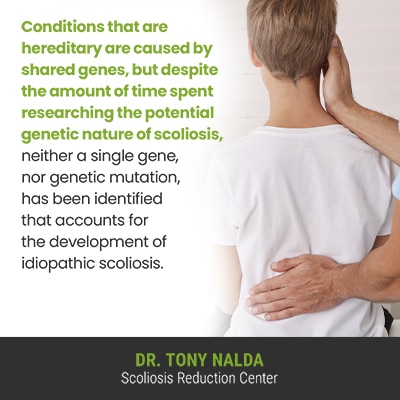The chances of getting scoliosis will depend on the type in question, and as the main type of scoliosis is idiopathic, meaning cause unknown, we’ll focus on the prevalence of idiopathic scoliosis. Continue reading to learn about the most common type of idiopathic scoliosis and its multifactorial nature.
The chances of getting idiopathic scoliosis do increase if another member of the family has been diagnosed, but it’s generally accepted that this is because scoliosis is more familial, than genetic; families share a lot more than just their genes.
Before exploring the difference between a condition being familial or genetic, let’s first talk about the different types of scoliosis.
Being Diagnosed with Scoliosis
Being diagnosed with scoliosis means an unnatural sideways spinal curve that also rotates has developed; it’s the spine’s rotation that makes it a complex 3-dimensional condition.
In addition, scoliosis is a progressive condition, meaning its nature is to worsen over time, and part of diagnosing scoliosis involves further classifying conditions based on key patient/condition variables.
Scoliosis progressing means the size of the unnatural spinal curve is increasing, as are the condition’s uneven forces, and their effects; in addition, scoliosis progressing means the spine is getting increasingly rigid, making it less responsive to treatment.
While there are no treatment guarantees, in cases that are caught early and responded to with a proactive treatment plan, there are fewer limits to what can be achieved; the milder a scoliosis is, the simpler it can be to treat.
Classifying conditions helps streamline the treatment process and informs the crafting of customized treatment plans, and scoliosis is classified based on patient age, condition severity, curvature location, and type is determined by causation.
Different Types of Scoliosis

Scoliosis is often called a complex condition to treat not only because it’s progressive and ranges widely in severity from mild to moderate and severe to very severe, but also because there are different types a patient can develop.
The most common type of scoliosis to affect both children and adults is idiopathic scoliosis, and idiopathic scoliosis accounts for approximately 80 percent of known diagnosed cases; the remaining 20 percent is associated with known causes.
Neuromuscular scoliosis is caused by the presence of a larger neuromuscular condition such as spina bifida, muscular dystrophy, or cerebral palsy.
Degenerative scoliosis is caused by natural age-related spinal degeneration, and congenital scoliosis is caused by a malformed spine that develops in utero.
Idiopathic means not clearly associated with a single-known cause, and this isn’t the same as saying there is a complete absence of a cause; in fact, the general consensus is that idiopathic scoliosis is considered to be multifactorial, meaning caused by a combination of variables that can vary from person to person.
There are all sorts of theories regarding factors that contribute to the development of idiopathic scoliosis, and current estimates have close to seven million people currently living with scoliosis in the United States alone.
The most prevalent type of scoliosis, overall, is adolescent idiopathic scoliosis (AIS), diagnosed between the ages of 10 and 18, so let’s explore the onset and progression of AIS.
What is Adolescent Idiopathic Scoliosis?
Adolescent idiopathic scoliosis is diagnosed in adolescents who are in, or are entering into, the stage of puberty.
While we don’t fully understand what triggers the initial onset of adolescent idiopathic scoliosis, we do understand what triggers its progression: growth and development.
Adolescents are the age group most at risk for rapid-phase progression due to the rapid and unpredictable growth spurts of puberty.
When I diagnose adolescents with idiopathic scoliosis, it’s difficult to explain, particularly to parents and/or caregivers, that we don’t fully understand what causes it to develop, and a natural question I’m met with is whether or not scoliosis is hereditary.
What Are the Chances of Getting Scoliosis?
Conditions that are hereditary are caused by shared genes, but despite the amount of time spent researching the potential genetic nature of scoliosis, neither a single gene, nor genetic mutation, has been identified that accounts for the development of idiopathic scoliosis.
To cloud the issue even more, however, it has been found that the incidence of scoliosis does increase within families. So if a family member has been diagnosed with scoliosis, it is a risk factor for other members.
Now, this can seem like a point in favor of the argument that scoliosis is genetic, but remember, families share a lot more than just their genes, and idiopathic scoliosis is, again, thought to be multifactorial.
Families share a number of traits including lifestyle, diet, body type, location, socioeconomic factors, responses to stress, posture, etc.

Twin studies support the familial argument with results showing cases of twins where one has scoliosis, and the other does not, and in other cases where both twins have scoliosis, but they are different condition types and/or are different curvature types and patterns.
Perhaps, the multifactorial nature of idiopathic scoliosis lends itself well to causation that’s attributed to a combination of heritability and environmental factors.
What I comfort patients, and their families with, is that while we don’t fully understand what triggers the condition’s initial onset in adolescence, we do know what triggers its progression: growth and development.
In addition, knowing what causes it wouldn’t necessarily change the course of treatment, or its outcome; the most important thing is how a diagnosis of scoliosis is responded to in terms of treatment.
How is Idiopathic Scoliosis Treated?
There are two main scoliosis treatment approaches for patients to choose between, and I want to make sure the differences are known because treatment will affect long-term spinal health and function.
Traditional scoliosis treatment offers a surgical response, while modern conservative scoliosis treatment offers patients a non-surgical treatment alternative.
Here at the Scoliosis Reduction Center®, I address the progressive structural spinal condition with a proactive conservative treatment approach.
I customize each and every treatment plan around key patient/condition variables and can adjust based on how the spine is responding to growth and/or treatment.
A conservative approach is proactive, meaning it’s started as close to the time of diagnosis as possible in the hopes of preventing progression, and it integrates multiple condition-specific treatment disciplines so conditions are impacted on every level.
Chiropractic care involves a number of techniques and manual adjustments that work towards repositioning the curve’s most-tilted vertebrae back into alignment with the rest of the spine.
Once I start to see the condition impacted on a structural level in the form of a curvature reduction, I can work towards increasing core strength so the spine’s surrounding muscles can optimally support it: a large part of the spine’s ability to maintain its natural curves and alignment.
Physical therapy and scoliosis-specific exercises (SSEs) can strengthen the abdominal and back muscles, improve posture, address any related muscle imbalance, and activate specific areas of the brain for improved brain-body communication.
Corrective bracing is particularly effective on growing spines so is a regular facet of treatment for adolescent idiopathic scoliosis treatment; it helps augment corrective treatment results by pushing the spine into a corrective position.
Rehabilitation can involve continued chiropractic care and a series of custom-prescribed home exercises to further stabilize and heal the spine.
Conclusion
Scoliosis is a highly-prevalent structural spinal condition, and as a progressive condition, there is no known cure, but it can be highly treatable.
Idiopathic scoliosis is the most common type of scoliosis to affect both children and adults, and adolescent idiopathic scoliosis, diagnosed between the ages of 10 and 18, is the condition’s most common type overall.
Estimates are that approximately 4 out of 100 adolescents will be diagnosed with adolescent idiopathic scoliosis.
It’s estimated that approximately 30 percent of adolescents diagnosed with AIS have another family member with scoliosis, and while this can seem to support the argument in favor of scoliosis being genetic, it also supports the familial assertion that scoliosis is caused by a combination of variables that are shared amongst family members.
So if someone in the family is diagnosed with scoliosis, this is considered a risk factor; it doesn’t guarantee another’s diagnosis, just increases the likelihood of one.
So when it comes to idiopathic scoliosis, we don’t fully understand what triggers its initial onset, but the general consensus is that scoliosis is more accurately considered familial, than genetic.
It’s also important for patients to understand that knowing its causation wouldn’t secure a better prognosis, but how a condition is treated can.




